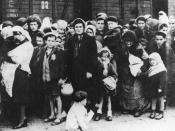The first research in the late 1940s and early 1950s focused on the Jewishness of the Holocaust. Called the "Final Solution" by the Germans, it was the object of two pivotal studies, both of which had the Jews at the center of their treatment. The first was The Final Solution by Gerald Reitlinger and the second The Destruction of the European Jews by Raul Hilberg. Most major studies since have had the same focus: Lucy Dawidowicz (The War Against the Jews; Leni Yahil (The Holocaust); Hilberg (Perpetrators, Victims, Bystanders); Daniel Goldhagen (Hitler's Willing ers); Martin Gilbert (The Holocaust); Arad et al (Documents on the Holocaust); Yitzak Arad (Belzec, Sobibor, Treblinka: The Operation Reinhard Camps) and so on.
Modern research has begun to deal more extensively with the suffering of other victims of the genocide. For example, homosexuals, Gypsies, prisoners of war, Russians, Poles, Catholic priests, Jehovah's Witnesses and others were more or less systematically ed as the Holocaust continued.
By the end of the war, as many as 6 million of these people had been killed, along with between 5 and 6 million Jews.
Does the focus on the Jewishness of the Holocaust take away from or minimize the suffering of the millions of non-Jews who were persecuted? Do the Jews, unintentionally perhaps, try to keep all the suffering for themselves? No. On the other hand, does the Holocaust have a particularly crucial and central Jewish element, even though millions of others died? Simply put, the answer is yes. The Holocaust, from its conception to its implementation had a distinctly Jewish aspect to it and, arguably without this Jewish aspect, there would have been no Holocaust. Most of the non-Jewish people would not have been killed because the machinery would not have been put into operation.
In this context, two...


